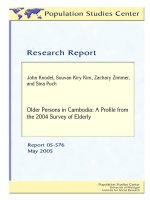MORPHOLOGY morphemes In linguistics, a morpheme is the smallest grammatical
Bạn đang xem bản rút gọn của tài liệu. Xem và tải ngay bản đầy đủ của tài liệu tại đây (347.51 KB, 10 trang )
MORPHOLOGY
FREE AND BOUND MORPHEMES
In linguistics, amorphemeis the smallest
grammatical unit in a language. The field of
study dedicated to morphemes is called
morphology. A morpheme is not identical
to a word, and the principal difference
between the two is that a morpheme may
or may not stand alone, whereas a word,
by definition, is freestanding. When it
stands by itself, it is considered a
root because it has a meaning of its own
MORPHEMES
E.g. the morpheme cat.
and when it depends on another morpheme to
express an idea, it is an affix because it has a
grammatical function.
E.g. the –s in cats to specify that it is plural.
Every word comprises one or more morphemes.
The more combinations a morpheme is found in,
the more productive it is said to be.
MORPHEMES
Example:
"Unbreakable" comprises three morphemes:
un- (a bound morpheme signifying "not"),
-break- (the root, a free morpheme),
and -able (a free morpheme signifying "can be
done").
Allomorphs of the plural morpheme for regular
nouns: /s/ (e.g. in cats /kæts/),
/ z/ɨ (e.g. in dishes /d z/), ɪʃɨ
and /z/ (e.g. in dogs /d z/). ɒɡ
MORPHEMES
Every morpheme can be classified as either free
or bound. These categories are mutually
exclusive, and as such, a given morpheme will
belong to exactly one of them.
CLASSIFICATION OF MORPHEMES
FREE VS. BOUND
Free morphemes can
function independently as
words
(e.g. town, dog)
and can appear with other
lexemes
(e.g. townhall, doghouse)
CLASSIFICATION OF MORPHEMES
FREE VS. BOUND
Bound morphemes appear only as
parts of words, always in conjunction
with a root and sometimes with other
bound morphemes.
•
For example, un- appears only
accompanied by other morphemes to
form a word. Most bound morphemes in
English are affixes,
particularly prefixes and suffixes,
Examples of suffixes are: tion, ation,
ible, ing, etc.
•
Bound morphemes that are not affixes
are called cranberry orphemes.
•
Bound morphemes can be further
classified as derivational or
inflectional.
Derivational morphemes, when combined with a
root, change either the semantic meaning or part of
speech of the affected word.
For example, in the word happiness, the addition of
the bound morpheme -ness to the
root happy changes the word from an adjective
(happy) to a noun (happiness).
In the word unkind, un- functions as a derivational
morpheme, for it inverts the meaning of the word
formed by the root kind.
MORPHEMES
Inflectional morphemes modify a verb’s
tense or a noun's number without affecting
the word's meaning or class. Examples of
applying inflectional morphemes to words are
adding -s to the root dog to form dogs and
adding -ed to wait to form waited. In English,
there are eight inflections.
MORPHEMES
FREE MORPHEMES
MORPHEMES
BOUND MORPHEMES
DERIVATIONAL
INFECTIONAL
_ ness: happy - happiness
_ly: love - lovely
un-, in-, im-, en-, re- …
Ex: kind - unkind
formal – imformal
do - redo
modify a verb’s tense
Ex: adding –s
dog
dogs
adding –es
watch
watches
or modify a noun's number
Ex: adding –ed
wait
waited
adding –s
get up
she gets up









